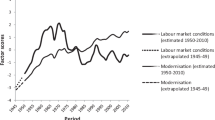Abstract
This chapter sheds light on retirement behaviour in the executive labour market segment, presenting characteristics and trends in the market for executives’ post-career activities and employing Switzerland as a case in point. The observations are based on a dataset comprising the 104 executives who retired from top management positions at 50 of the largest publicly listed Swiss companies and left the executive labour market between 2006 and 2008. The findings show that there is an emerging market for post-executive activities in Switzerland, and that the type, intensity, and location of activities pursued in the post-executive labour market are related to the demographic characteristics and career profiles of retiring executives.
1Acknowledgements: We thank Ksenia Kozhukovskaya for contributing to this chapter by sharing data collected for her master thesis at the University of St. Gallen.
Access this chapter
Tax calculation will be finalised at checkout
Purchases are for personal use only
Preview
Unable to display preview. Download preview PDF.
Similar content being viewed by others
References
Adler, P. S., & Kwon, S.-W. (2002). Social capital: Prospects for a new concept. Academy of Management Review, 27, 17-40.
Becker, G. S. (1975). Human capital: A theoretical and empirical analysis, with special reference to education. New York: Columbia University Press.
Ben-Porath, Y. (1967). The production of human capital and the life cycle of earnings. Journal of Political Economy, 75, 352-365.
Bird, A. (1994). Careers as repositories of knowledge: A new perspective on boundaryless careers. Journal of Organizational Behavior, 15, 325-344.
Blau, D. M. (1994). Labour force dynamics of older men. Econometrica, 62, 117-156.
Burt, R. S. (1992). Structural holes: The social structure of competition. Cambridge/London: Harvard University Press.
Bütler, M., Huguenin, O., & Teppa, F. (2005). What triggers early retirement? Results from Swiss pension funds. DNB Working Paper 41/2005.
Carpenter, M. A., Geletkanycz, M. A., & Sanders, W. G. (2004). Upper echelons research revisited: Antecedents, elements, and consequences of top management team composition. Journal of Management, 30, 749-778.
Certo, S. T., Lester, R. H., Dalton, C. M., & Dalton, D. R. (2006). Top management teams, strategy and financial performance: a meta-analytic examination. Journal of Management Studies, 43, 813-839.
Coleman, J. S. (1988). Social capital in the creation of human capital. American Journal of Sociology, 94, S95-S120.
Fama, E. F. (1980). Agency problems and the theory of the firm. Journal of Political Economy, 88, 288-307.
Feldman, D. C. (1994). The decision to retire early: A review and conceptualization. Academy of Management Review, 19, 285-311.
French, E. (2005). The effects of health, wealth, and wages on labour supply and retirement behaviour. Review of Economic Studies, 72, 395-427.
Granovetter, M. (1992). The sociological and economic approaches to labor market analysis: A social structural view. In M. Granovetter & R. Swedberg (Eds.), The Sociology of Economic Life (pp. 233-263). Boulder, CO: Westview Press.
Gruber, J., & Wise, D. (1998). Social security and retirement: An international comparison. American Economic Review, 88, 158-163.
Hambrick, D. C. (2007). Upper echelons theory: an update. Academy of Management Review, 32, 334-343.
Harris, D., & Helfat, C. (1997). Specificity of CEO human capital and compensation. Strategic Management Journal, 18, 895-920.
Kim, S., & Feldman, D. C. (2000). Working in retirement: The antecedents of bridge employment and its consequences for quality of life in retirement. Academy of Management Journal, 43, 1195-1210.
Lazear, E. P. (1979). Why is there mandatory retirement? Journal of Political Economy, 87, 1261-1284.
Mizruchi, M. S. (1996). What do interlocks do? An analysis, critique, and assessment of research on interlocking directorates. Annual Review of Sociology, 22, 271-298.
Murphy, K. J., & Zabojnik, J. (2004). CEO pay and appointments: A market-based explanation for recent trends. American Economic Review, 94, 192-196.
Rosen, S. (1992). Contracts and the market for executives. In L. Werin & H. Wijkander (Eds.), Contract economics (pp. 181-211). Oxford, UK: Blackwell.
Ruhm, C. J. (1990). Bridge jobs and partial retirement. Journal of Labor Economics, 8, 482-501.
Stock, J. H., & Wise, D. A. (1990). Pensions, the option value of work, and retirement. Econometrica, 58, 1151-1180.
Westphal, J. D. (1999). Collaboration in the boardroom: Behavioral and performance consequences of CEO-board social ties. Academy of Management Journal, 42, 7-24.
Author information
Authors and Affiliations
Editor information
Editors and Affiliations
Rights and permissions
Copyright information
© 2011 Springer-Verlag Berlin Heidelberg
About this chapter
Cite this chapter
Greve, P., Ruigrok, W. (2011). Stepping down but not out – Characteristics of post-executive careers in Switzerland. In: Boppel, M., Boehm, S., Kunisch, S. (eds) From Grey to Silver. Springer, Berlin, Heidelberg. https://doi.org/10.1007/978-3-642-15594-9_12
Download citation
DOI: https://doi.org/10.1007/978-3-642-15594-9_12
Published:
Publisher Name: Springer, Berlin, Heidelberg
Print ISBN: 978-3-642-15593-2
Online ISBN: 978-3-642-15594-9
eBook Packages: Business and EconomicsBusiness and Management (R0)




